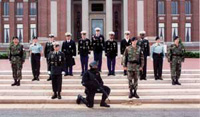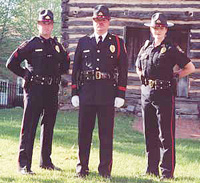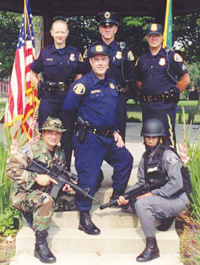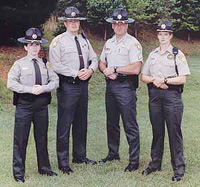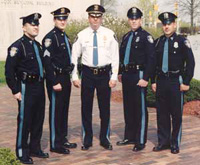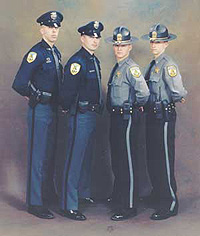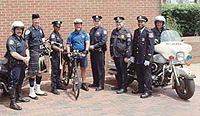|
By Ernie Jackson, NAUMD
Police work can be very dangerous and stressful. In addition to the obvious dangers of confrontations with criminals, officers need to be constantly alert and ready to deal appropriately with a number of other threatening situations. Many law enforcement officers witness death and suffering resulting from accidents and criminal behavior. A career in law enforcement may take a toll on officers private lives.
People depend on police officers and detectives to protect their lives and property. Law enforcement officers, some of whom are state or federal special agents or inspectors, perform these duties in a variety of ways, depending on the size and type of their organization. In most jurisdictions, they are expected to exercise authority when necessary, whether on or off duty. According to the U.S. Bureau of Justice Statistics, about 65% of state and local law enforcement officers are uniformed personnel.
Amazingly, despite the known job hazards, the number of qualified candidates exceeds the number of job openings in federal and state law enforcement agencies, according to reports issued by the U.S. Department of Labor.
There is good news for the applicants that do not find work at the federal and state level. The number of candidates is currently inadequate to meet growth and replacement needs in many local and special police departments.
Police and detectives made up about 834,000 jobs in 2000, and about 80% of them were employed by local governments. State police agencies employed about 13% and various federal agencies employed about 6%. A small proportion worked for schools, railroads, transit agencies, or private detective, guard, and armored car services.
The number of employment opportunities will rise fastest in urban communities with relatively low salaries and high crime rates.
According to the U.S. Bureau of Justice Statistics, police and detectives employed by local governments primarily worked in cities with more than 25,000 inhabitants. Some cities have very large police forces, while thousands of small communities employ fewer than 25 officers each. Forty-six local, special and state agencies employed 1,000 or more full-time sworn officers, while approximately 7,000 departments employed fewer than 10 each.
Sheriffs and deputy sheriffs enforce the law on the county level. Sheriffs departments tend to be relatively small, most having fewer than 25 sworn officers. A deputy sheriff in a large agency will have law enforcement duties similar to those of officers in urban police departments. Nationwide, about 40% of full-time sworn deputies are uniformed officers assigned to patrol and respond to calls.
State police officers (sometimes called state troopers or highway patrol officers) arrest criminals statewide and patrol highways to enforce motor vehicle laws and regulations. State law enforcement agencies operate in every State except Hawaii. Seventy percent of the full-time sworn personnel in the 49 state police agencies are uniformed officers who regularly patrol and respond to calls for service.
Public college and university police forces, public school district police and agencies serving transportation systems and facilities are examples of special police agencies. There are more than 1,300 of these agencies with special geographic jurisdictions or enforcement responsibilities in the United States. More than 75% of the sworn personnel in special agencies are uniformed officers, and about 15% are investigators.
The types of departments in many police organizations have become very specialized. Along with this trend have come specific clothing developments. Far beyond simple adjustments in the apparel for temperature considerations (warm for winter; cool for summer). On the one hand, there often are high performance needs for special forces. At the other extreme, additional administrative workers desire more comfortable indoor fashions.
The levels of responsibility and variety of tasks performed by todays law enforcement agencies has increased to such an extent that the one look, one style uniform is an approach of the past. Special occasion uniforms are a part of many programs. Garments appropriate for work on motorcycles, bicycles, horses and foot patrol are needed. Locations maintained by a uniformed officers presence, such as national parks, amusements parks, airports, beaches and marinaseach offer a unique challenge for clothing suiting the environment.
Uniform manufacturers, dealers and distributors are responding to the request. Fabrics today feature more dynamic functionality than ever. Contemporary blends help the body better handle temperature shifts. Modern fabric treatments will absorb, conceal, repel, retard and reflect just about anything thrown at the threads.
Employment of police and detectives is expected to increase faster than the average for all occupations through 2010. A more security-conscious society and higher concern about drug-related crimes should contribute to the increasing demand for police services. At the local and state levels, growth is likely to continue as long as crime remains a serious concern. However, employment growth at the federal level will be tempered by continuing budgetary constraints faced by law enforcement agencies.
The level of government spending determines the number of police officers. The number of job opportunities, therefore, can vary from year to year and from place to place. Layoffs, on the other hand, are rare because retirements enable most staffing cuts to be handled through attrition.
Each year, the National Association of Uniform Manufacturers and Distributors (NAUMD) presents the Best Dressed Police Department Awards to participating law enforcement organizations. In 2002, this included programs from all parts of the United States, from Connecticut to Utah. The competition also honored a few of the special services law enforcement operationssuch as Michigans Department of Natural Resources Law Enforcement division and the U.S. Mint Police Department.
Made To Measure Magazine presents these fine examples of quality uniform programs to showcase the enormous law enforcement segment of the uniform industry and the variety of opportunities to be found within this niche.
|




